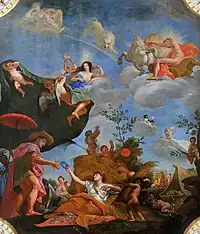
Plafond Allegory of Summer by Jerzy Siemiginowski-Eleuter, 1684–86, oil on canvas and panel, Wilanów Palace, Warsaw.[1]
A plafond (French for "ceiling"), in a broad sense, is a (flat, vaulted or dome) ceiling.
A plafond can be a product of monumental painting or sculpture. Picturesque plafonds can be painted directly on plaster (as a fresco, oil, glutinous, synthetic paints), on a canvas attached to a ceiling (panel), or a mosaic.
As a decorative feature of churches and staterooms, plafonds were popular from the 17th century until the beginning of the 19th century. Designs of this period typically used illusionistic ceiling painting showing the architectural structure behind, strongly foreshortened figures, architectural details, and/or the open sky.
References
- ↑ (in English) "The King's Bedroom". wilanow-palac.art.pl. Retrieved 21 February 2008.
This article is issued from Wikipedia. The text is licensed under Creative Commons - Attribution - Sharealike. Additional terms may apply for the media files.